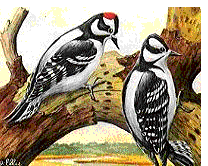Two downy woodpeckers - a
male and a female - were seen by Pat Mattson  on June 11,2000. They were located in
trees alongside the outlet from the Black Gum Swamp. This portion of
the property has numerous broad-leaved trees, among them shag-bark
hickories. A stone wall can be seen in the wooded area, indicating
that portions of the Hackett Hill property were farmland at one time
- probably at least a century ago.
on June 11,2000. They were located in
trees alongside the outlet from the Black Gum Swamp. This portion of
the property has numerous broad-leaved trees, among them shag-bark
hickories. A stone wall can be seen in the wooded area, indicating
that portions of the Hackett Hill property were farmland at one time
- probably at least a century ago.
The striking black and white plumage of these birds has been described as having a formal tuxedo-like appearance.The adult male has a distinct red patch on the back of its head.
Downy woodpeckers are common throughout North American woodlands and also visit backyard feeders whenever suet and peanut butter are offered.
Although downy woodpeckers possess the anatomical characteristics of the woodpecker family that enable them to excavate wood (see Pileated Woodpecker), they are very small - only 15-17 cm in length.
A breeding pair of downy woodpeckers establish a territory in the spring, in part by drumming short, fast tattoos on wood. They excavate a flask-shaped nest cavity in a suitable tree. Here, the female lays 4-7 eggs which are incubated in shifts by both parents. After the eggs hatch the parents bring food to the nestlings and keep the nest clean. Fledglings follow their parents throughout the treetops and begin to assume adult plumage.
Downys are non-migratory. However
they do not cache food for the winter but continue to seek insects in
infested trees during this season.
Credits: The illustration of the downy woodpeckers appears on the
web site, Wildlife
Neighbors of the Williamsburg Area.
![]() PERTINENT LINK
PERTINENT LINK